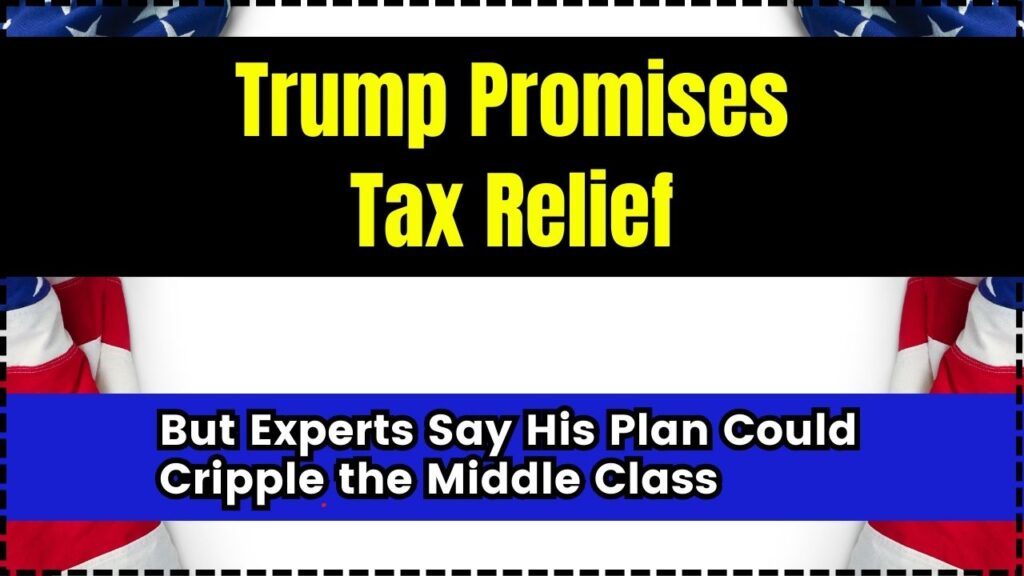
Trump Promises Tax Relief: President Donald Trump is once again shaking things up in Washington with his new tax plan, dubbed the “One Big Beautiful Bill.” It’s designed to bring tax relief to Americans, but many experts and economists are warning that it could cripple the middle class. This article will break it all down in a way that’s easy to follow—whether you’re a pro investor or just trying to keep your family’s budget in check.
Trump Promises Tax Relief
President Trump’s “One Big Beautiful Bill” might promise tax relief, but many experts caution it’s a Trojan horse. The wealthy stand to gain the most, while the middle class could face higher costs and reduced access to essential services. The plan’s potential to balloon the deficit and widen economic inequality makes it a risky bet for most Americans.
| Feature | Details |
|---|---|
| Tax Cuts Distribution | Middle-class households (earning $51,000–$93,000) get an average tax cut of $815, while the top 1% see about $44,000, and the top 0.1% score over $390,000. |
| Child Tax Credit Increase | A $500 boost to the child tax credit, totaling $2,500 per child. |
| Elimination of Certain Taxes | Federal taxes on tips, overtime, and Social Security benefits would be removed. |
| “MAGA” Savings Accounts | $1,000 starter accounts for kids born 2024–2028, with family contributions up to $5,000/year. |
| Cuts to Social Programs | Reductions to Medicaid, food assistance, and other services to offset tax cuts. |
| National Deficit Projection | Plan could add $3 trillion to the deficit over the next decade. Source |
What’s the Buzz About?
Trump’s proposed plan isn’t just about handing out savings—it’s about changing how taxes work for everyone. On paper, it sounds like a win: middle-class folks could see tax cuts, parents might get more child tax credits, and workers could keep more of their overtime and tip earnings. But hold on—there’s more to this story.
Historical Context: How Does This Compare?
This plan echoes the 2017 Tax Cuts and Jobs Act, which gave big breaks to corporations and high earners but left many middle- and low-income Americans feeling shortchanged. Past tax reforms, like those in the Reagan era, also promised widespread benefits but later faced criticism for ballooning deficits and increasing inequality. Trump’s latest proposal seems to follow a familiar playbook, raising questions about who really wins in these sweeping reforms.
The Nuts and Bolts: What’s in the Plan of Trump Promises Tax Relief?
Tax Cuts and Distribution
The average middle-class family might get a tax cut of $815, but the top 1% would walk away with $44,000 or more. The wealthiest 0.1% could see benefits upwards of $390,000. That’s a huge gap, and it’s making folks wonder: is this really “for the people,” or just for the top dogs?
Child Tax Credit Boost
Raising the child tax credit from $2,000 to $2,500 per kid sounds great. It’s a win for families struggling with childcare costs. But this benefit might not outweigh the downsides of slashed social programs.
Eliminating Certain Taxes
Getting rid of taxes on tips, overtime, and Social Security sounds like a way to help working Americans. It puts more money directly into paychecks—but again, experts warn it might be too little to offset cuts in essential services.
“MAGA” Savings Accounts
These accounts, starting with $1,000, are designed to help families save for the future. But contributions are capped at $5,000/year, which might not be enough to make a real difference for most families.
Cuts to Social Programs
To make these tax breaks possible, Trump’s plan slashes Medicaid, food assistance, and other vital programs. This could leave millions without healthcare or enough to eat.
National Deficit Risks
The Congressional Budget Office (CBO) projects that the plan could add $3 trillion to the deficit over the next decade, raising alarms about the country’s financial future.
Economic and Professional Impact
For businesses and high earners, this plan looks like a gold mine. Corporations may see lower tax burdens, potentially boosting profits. But small businesses might not get the same perks, and cuts to public services could impact local economies. Investors might welcome short-term gains, but the long-term debt load could create economic instability.
What Should You Do?
Here’s how to prepare:
- Review your tax situation: Check how proposed changes might affect your family or business.
- Budget for social services: If you rely on Medicaid or SNAP, prepare for possible reductions.
- Consider long-term savings: Even with “MAGA” accounts, explore other options like 529 plans or IRAs.
- Stay informed: Follow updates from trusted sources like the IRS and CBO.
Expert Insights
Dr. Linda Martinez, an economist at Georgetown University, warns:
“This plan promises relief, but in reality, it’s a wealth transfer. It takes from the middle and gives to the top, with potential long-term harm to essential services and the broader economy.”
Social Security Payments Frozen for Some Retirees—Do You Owe These Debts?
Social Security Checks With COLA Drop May 28; Here’s Who’s Getting the Bigger Payments
Big $5,108 Social Security Checks Hitting Accounts This Week — See If You Qualify!
Frequently Asked Questions (FAQs)
Q1: Who benefits the most from this plan?
High-income earners and large corporations stand to gain the most, with tax cuts disproportionately favoring the wealthy.
Q2: How does this impact middle-class families?
While middle-class households might get a small tax cut, it may be offset by cuts to social programs and rising national debt.
Q3: Will the plan actually pass?
The bill has passed the House but faces an uncertain future in the Senate, with some Republicans and most Democrats opposing it.
Q4: What can I do to prepare?
Stay updated, review your financial plan, and consult with tax professionals to prepare for potential changes.
Q5: How does this compare to past tax plans?
Similar to the 2017 reforms, this plan heavily favors the wealthy while risking increased deficits and cuts to social programs.











